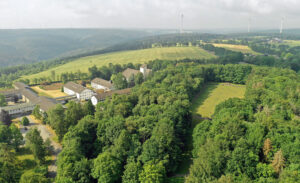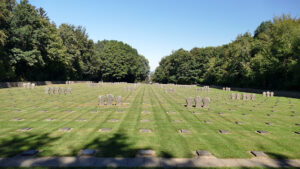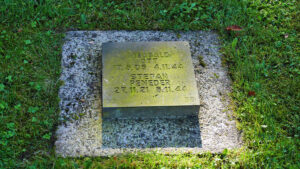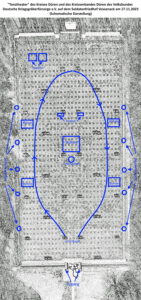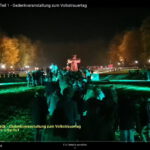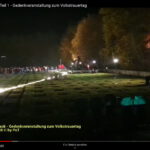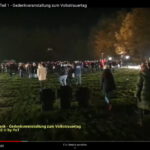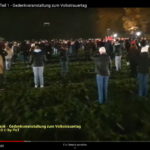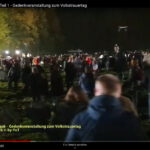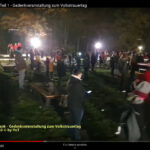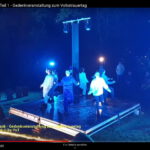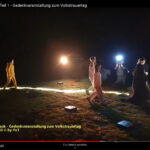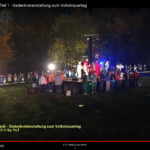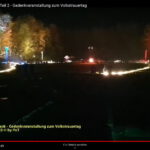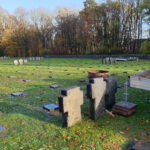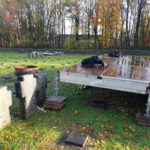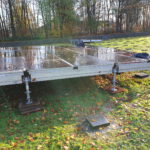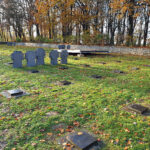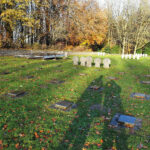“Modern culture of remembrance” in the District of Düren: The “Dance Theater” over the graves of the war dead at the military cemetery in Vossenack on the occasion of Remembrance Day (“Volkstrauertag”) 2023 (Published on 19/08/2024, latest update on 30/08/2024)
I. The “commemorative event” for Remembrance Day 2022: The play before the play
Looking back, the administration of the District of Düren under District Administrator Wolfgang Spelthahn (CDU, Conservative party), once again actively supported by Aachener Zeitung, had already prepared the ground in 2022 for an event that could one day have symbolic significance for the conditions in Germany in the 2020s: the so-called “Tanztheater” (“dance theater”), which was performed on the occasion of Remembrance Day 2023 directly above the graves of the war dead in the military cemetery in Vossenack.
As reported on this blog, the District of Düren’s official commemorative event the for Remembrance Day, which until then had always been held on Remembrance Day itself, alternately at the military cemeteries in Hürtgen and Vossenack, was, for the first time in 2022, postponed to a Friday afternoon after a two-year break due to the “corona” virus. Not just any Friday, but to November 11th, the start of the new session of carnival in the Rhineland, which is usually celebrated by many people with a boozy and cheerful atmosphere. To the alleged surprise of the protagonists, it was essentially they themselves who showed up for this event at 16:00. The widespread sympathy that is usual on Remembrance Day, especially from the local population, was absent, which is hardly surprising given the date.
Nevertheless, in an article published the following day under the title “Volkstrauertag – aber kaum niemand geht hin” (“Remembrance Day – But hardly anybody is showing up”) Aachener Zeitung immediately complained about the alleged decline in the importance of Remembrance Day – curiously, before the memorial day had even taken place! While most of the content of the Aachener Zeitung is usually behind a paywall, this article was freely accessible. It was therefore evidently desired that its content be widely disseminated.
The author of the article, Sarah Berners, attributed the alleged loss of significance of Remembrance Day to the low number of participants at the event, which was ultimately largely due to the obviously unfortunate choice of date and thus to the organizers themselves. At the same time, in a commentary she dutifully called for “new concepts”, otherwise “Remembrance Day will disappear”. While the author had not previously given the impression that she was particularly interested in commemorating the war dead, she now verbosely called for “a new concept for Remembrance Day”; “a new form” in which schools, clubs and youth groups should be involved (all citations translated from German language).
Perhaps not coincidentally, this created a great opportunity for CDU District Administrator Spelthahn, who did not need to be told twice. To the self-created problem, he was now able to present a solution corresponding to his ideas: a so-called “dance theater” by schoolchildren directly above the graves of the war dead.
II. Once again: The District of Düren’s cemetery rules
First of all, one may recall the currently applicable “Cemetery rules for the Hürtgen and Vossenack War Cemeteries” issued by the District of Düren on 13/09/2022 (“FO 2022”). As is well known, since autumn 2022 the District of Düren has generally prohibited visitors to these military cemeteries from placing there, for example, flowers or candles, without having previously received an exemption permit; violations have been declared an administrative offence.
These cemetery rules state in sec. 4 cipher 1. (translated from German language):
“The war cemeteries are places of mourning, remembrance of the dead and reflection. Visitors to the war cemeteries must behave in a manner that reflects the dignity of the place.”
According to sec. 4 cipher 4. i) FO 2022, it is “particularly not permitted” in the two military cemeteries (translated from German language),
“to make noise, play games or otherwise disturb the peace of the dead (in particular music performances and the use of sound carriers),”
Accordingly, the District of Düren considers musical performances and the use of sound recordings in the military cemeteries to be a disturbance of the peace of the dead, as is making noise and playing on the grounds. This should be kept in mind.
III. The announcement of a “dance theater on the occasion of Remembrance Day” by the District of Düren
In a press release dated 08/11/2023 [archive link], the District of Düren announced that “in memory of the victims of war and tyranny, but also as a sign of a peaceful future” a newly designed memorial event on the occasion of Remembrance Day would take place in Vossenack on Friday, 17/11/2023 from 17:30. Pupils at Franziskus-Gymnasium Vossenack had “developed a program under the name ‘Facing Peace’” that would “provide a new impetus for remembrance”. “Facing Peace” should mean “giving peace a face” (all citations translated from German language).
District Administrator Spelthahn, who in this capacity is also chairman of the Düren district association of Volksbund Deutsche Kriegsgräberfürsorge e. V. (“Volksbund”, the German War Graves Commission), was quoted by his press office as saying )translated from German language):
“We must not forget the horrors of war and must preserve memory. Unfortunately, we are confronted with war in the news every day. We must ensure that peace is maintained with us and I am very grateful that the youth have made this their task.”
Who does Mr Spelthahn actually mean when he speaks of “we”?
The commemorative event in question would begin “with a performance by pupils in the Vossenack monastery church”, where the Gymnasium’s “’exART’ music theater under the direction of teacher Clemens Amendt will address the ‘wrong path of war’ in a production”. This would be followed by a 300-meter-long walk to the military cemetery through “the labyrinth of peace”. The latter would consist of “numerous lights, also set up by the school”, and illuminate “the path to the pedestal of peace” in the middle of the cemetery. There, “the wreaths will be laid and words of remembrance will be spoken” (all citations translated from German language).
Franziskus-Gymnasium would also be performing the theater on Saturday, 18/11/2023 at the same time.
The date of the event, which, like last year, was to be held two days before the actual Remembrance Day on 19/11/2023, was again explained with the District of Düren wanting to avoid scheduling conflicts with the commemorative events of the local associations.
IV. Franziskus-Gymnasium Vossenack and its music theater “exART”
The District of Düren under District Administrator Spelthahn is always happy to use the pupils of Franziskus-Gymnasium Vossenack when it comes to changing the traditional commemoration of the Second World War and its victims under the guise of “involving young people” and “modernization” in accordance with certain ideas in which, for instance, the traditional, religiously motivated customs of commemorating the dead – e.g. laying flowers or candles – apparently no longer play a role.
Conveniently, the Franziskus-Gymnasium, completed in 1967, is located directly next to the military cemetery in Vossenack, which was inaugurated in August 1952, on the so-called hill 470, which was heavily fought over in the Second World War. According to its own information, it is a “state-recognized Catholic private school run by the non-profit school company Franziskus-Gymnasium mbH” (“Support GmbH”). According to the school’s sponsor, the Franziskus Foundation, the Gymnasium currently has around 600 pupils.
The school’s current director is Dirk Sieven, and Alexander Fischer is the sole managing director of “Gemeinnützige Schulgesellschaft Franziskus-Gymnasium mbH” since 01/04/2023.
According to its entry in the commercial register (County Court Düren, HRB 2892), the object of this GmbH is “the promotion of the school system and the education of young people to lead a Christian life and to assume responsibility for the world based on Catholic faith” (citations translated from German language).
On the Franziskaner website there is a “short profile” [archive link] of Franziskus-Gymnasium, which states (translated from German language):
“The young person is at the center of teaching and education. (…)
Our task is to encourage them to discover and develop the image that God has placed in them. In addition to profound knowledge, the young person should learn to practice committed solidarity in a fraternal atmosphere towards everyone, especially towards the weak and disenfranchised in our world.
They should learn to be a representative voice for those who no longer have a voice in society and politics. They should also learn to set Jesus-oriented accents in their own lives and to love creation in a similar way to Francis of Assisi.”
Regarding its own mission statement, the school – with reference to the ideals of its namesake, Francis of Assisi – states that it attached importance to “meeting one another with respect and openness”, which first and foremost included “seeing people in their God-given dignity” (citations translated from German language).
The aforementioned music theater “exART” of Franziskus-Gymnasium, organized as a registered association, says of itself [archive link] that it would stage “musicals, plays and currently a rock opera with almost professional standards”. Once “developed from a school project”, “all musical productions are designed, developed and staged in-house”, “under the direction of author and director Clemens Amendt” (citations translated from German language). The “dance theater” is described in more detail on the “exART” website along with the event banner [archive link]. There you can read (, translated from German language, spelling and grammatical errors of the original corrected):
“Facing Peace – a production for peace!
Art has the task of entertaining us, but art of all kinds can do much more. Art has the ability to open up ‘spaces’ that often seem invisible or inaccessible in everyday life. Facing Peace wants to take the visitor on a very special journey – a journey that does not want to conceal anything, that takes a critical look at the current issues of war and peace, but at the same time wants to make the voice of peace tangible in a special way …. through dance, music, song, theater, light installation, etc. in two places that are predestined for such an extraordinary production:
40 actors, singers and dancers between the ages of 14 and 75 are staging a production in the Vossenack monastery church that explores the question of the fallacy of war mania. The focus is on Mother Nature (‘Gaia’), a warlord with his subjects and death. A dramatic play in which the warlord drowns in his own hatred at the end, but in which the incomprehensible suffering does not end in an inferno, but rather in a redemption.
The production continues on the neighboring illuminated war cemetery. In a dance theater, ‘Gaia’ and a young couple are at the center of the action. The young couple search for a way through the labyrinth of peace, not alone, but inspired by music…”
Further information about the “Facing Peace” project can be found on the “exART” YouTube channel with video statements by several protagonists. Said event banner states that the event was supported by the District of Düren, Franziskus-Gymnasium Vossenack, the Franziskus Foundation of the Franciscan Youth Work, the municipality of Hürtgenwald, the Simmerath trade association and EifelDrei.tv.
V. The “dance theater” at the Vossenack military cemetery on the evening of 17/11/2023
Interestingly, all the announcements described the actual content of the so-called “dance theater” at the military cemetery in Vossenack only incompletely and in a trivializing way.
What had been flowerily described in advance as a “labyrinth of peace” and a “pedestal of peace” in the middle of the cemetery consisting of “numerous lights” was in fact a multi-colored illumination of the burial ground, its impacting with the sound of loud music as well as singing and dancing on several stages erected directly above the graves, to which several hundred spectators were allowed to stream uncontrollably across the burial ground.
A YouTube channel called “Patriots on Tour” recorded the second part of the event, comprising the route from the monastery church on the grounds of Franziskus-Gymnasium to the burial ground of the neighboring military cemetery and the proceedings there, and published this recording in two parts. Part 1 covers the time from 18:28 to 19:12, Part 2 begins at 19:15 and ends at 19:48. You should watch these recordings to get a complete impression of the literal theater. A schematic representation of the situation and processes on the burial ground, created on the basis of these recordings, serves as an overview:
At the beginning of part 1 of the recording, people can be seen streaming in the semi-darkness from the grounds of Franziskus-Gymnasium to the neighboring military cemetery. The cemetery, where, according to Volksbund, 2,334 dead are currently buried, including civilians with children, numerous minesweepers and presumably also forced laborers, is illuminated and loud music is played. The stream of spectators initially moves along the flagstone path to the burial ground (see Part 1, until approx. 18:40:30). Five Bundeswehr soldiers in dress uniforms and some policemen have positioned themselves next to the high cross (Part 1, from 18:40:10). The three main protagonists of the “dance theater”, “Gaia” and “the peace couple”, have been set up on the wall directly at the entrances to the cemetery (Part 1, from approx. 18:39:54).
Behind the entrance, the stream of spectators moves freely and unguided across the burial ground in the semi-darkness. People swarm out, everyone looks for a place that suits them at will. Quite a few stand on the concrete border of the gravestones and thus directly on the grave of the war dead buried there (see Part 1, from approx. 18:40:30).
The burial ground is initially illuminated with white light by various spotlights placed at its edge; further lighting is directed at the autumn-colored trees at the edge of the burial ground. The lighting is later varied in color, apparently in reference to the colors of the rainbow. The organizers have laid white LED strips on the cemetery itself, which will later be followed by the protagonists. A total of five stages, each equipped with spotlights and loudspeaker masts, were erected directly above the graves, as well as two platforms from which the play will be recorded. From the middle, largest stage, teacher Amendt conducts the event and its audience with the help of a microphone (part 1, from approx. 18:43:30).
The performance begins with the entry of “Gaia and the peace couple”, who move from stage to stage along the LED strips across the burial ground. Each stage is illuminated in a single color, with young people dressed uniformly in this color on it, with whom the “peace couple” moves together, twitching to loud music (part 1, from approx. 18:46:30). At the end, all participants move from their uniformly colored stages to the central stage, where they form a multi-colored group – apparently again in the style of a rainbow – which jumps around together to loud music before finally singing (part 1, from approx. 19:07:00).
At 19:20 the spook is over.
Teacher Amendt informs those present “Sie dürfen applaudieren” (“You may applaud”), whereupon clapping and whistling begins over the graves of the more than 2,300 war dead, which continues for around 30 seconds (part 2, from approx. 19:20:00). A fire is then lit in a bowl in the middle of the burial ground, to which visitors can add pieces of wood laid out on the individual stages (part 2, from approx. 19:20:45).
The event is repeated on the next evening at the same time.
On Sunday, the actual Remembrance Day, the stages are still in place on the cemetery and prevent access to the graves below. Relatives of those buried there cannot access their graves.
VI. Press release from the District of Düren on 17/11/2023
Still the evening of 17/11/2023, the District of Düren published a press release on the event. Under the headline “Ein klares Zeichen für den Frieden” (“A clear sign for peace”), District Administrator Spelthahn had his press office announce (translated from German language):
“The pupils of Franziskus Gymnasium Vossenack developed an impressive and thought-provoking program for the commemorative event. The production took place in the completely filled Vossenack monastery church and on the neighboring and illuminated war cemetery. ‘Faceing Peace’ [sic!] was intended to express the fact that peace cannot be taken for granted and is not a gift. The performance by the Gymnasium’s ‘exART’ music theater, under the direction of teacher and organizer Clemens Amendt, offered the audience impressive insights into the current topic of war and peace.”
CDU District Administrator Spelthahn, “moved by the performance”, commented in his own press release as follows (translated from German language):
“Franziskus-Gymnasium Vossenack was built on this ground where so many people died. The staging of these young people today was a clear signal to deal with the value of peace. The insanity of war and violence became more than clear. We must stand up for peace together and never lose hope. May this sign of peace reach all the people in need.”
Once again, who does Mr Spelthahn actually mean when he talks about “we”?
VII. The coverage by Aachener Zeitung
Of course, the obligatory song of praise from Aachener Zeitung was not long in coming. In its Saturday edition [archive link] of 18/11/2023, it ran the headline „Modernisierung des Volkstrauertags – Jugendliche tanzen über den Gräbern getöteter Soldaten für den Frieden“ (“Modernization of Remembrance Day – young people dance over the graves of killed soldiers for peace”). This article is also freely accessible, again an unmistakable sign of the desire for wide distribution. The article, once again written by Ms Berners, describes the event as an “elaborate and impressive dance theater” with which “young people gave a new face to Remembrance Day” and “reminded us of peace in their own way” (all citations translated from German language).
At the beginning of the article, the alleged previous dreariness of Volkstrauertag is once again brought up, when the author makes a supposedly knowledgeable claim (translated from German language):
“Only a few people come to the commemoration ceremonies on Remembrance Day – and they have always been the same for years. The procedure follows tradition and we will see each other again next year.”
Of course, the event the evening before is described as having been the complete opposite of this (translated from German language):
“On Friday evening, the exArt music theater of Franziskus-Gymnasium took a completely new approach to remembrance and showed with an elaborate and moving dance theater what modern remembrance culture can look like.”
She added (translated from German language):
“The three [“Mother Gaia and the peace couple”] walked out of the church with their little light over an unrolled peace flag – followed by several hundred spectators, pupils, parents and siblings. The path led them all to the war cemetery, not just to the edge, but right up the middle. To the place where people were buried who died in a senseless war of extermination.
(…)
The 40-strong ensemble dances over the graves in temperatures just above freezing, without taking away the dignity of the place. On the contrary. The young people dance for peace, freedom and hope and make the place the starting point for their message. You could see in the eyes of the audience that it was getting through.”
Of course, Aachener Zeitung does not forget to pay homage to District Administrator Spelthahn and the other provincial political celebrities present. Author Berners’ melancholy homage to them (translated from German language):
“The District of Düren and Volksbund Deutsche Kriegsgräberfürsorge were prepared to make this significant change and to face up to the balancing act between tradition and the future: While the spectators – participation was compulsory for the pupils – walked from the church to the war cemetery, which was bathed in light, District Administrator Wolfgang Spelthahn (CDU), Volksbund Chairman Peter Kaptain and Hürtgenwald Mayor Stephan Cranen (FDP) paid their traditional silent tribute to the war dead in front of the cross, the wreaths and the eyes of all. They held up their illuminated cell phone displays from there for the drone photo of the ‘Peace Light’ – but watched the dance theater from the edge of the cemetery to build a bridge between tradition and the future. Changing the culture of remembrance can be a balancing act. However, there were only a few skeptical voices on Friday evening.”
One circumstance mentioned in the article only in passing is significant, as it shows how the desired event backdrop was apparently deliberately arranged:
“participation was compulsory for the pupils.”
VIII. Questions and answers on the “commemorative event” to the District of Düren
I subsequently asked the District of Düren for information on some of the circumstances of the “commemorative event” on the basis of the Freedom of Information Act of the State of North Rhine-Westphalia (“IFG NRW”).
1. Organizer and approval
First of all, I wanted to know who the organizer was, when permission for the event was granted and by whom.
The District of Düren informed me that it was a “joint event of the district association of Volksbund Deutsche Kriegsgräberfürsorge e.V. and the District of Düren”. Their events did not require approval “in accordance with sec. 5(4) of the cemetery rules” (translated from German language).
While the District of Düren under District Administrator Spelthahn is harassing visitors to the military cemeteries and threatening them with punishment for laying flowers or a grave candle without special permission, it is claiming the right to literally trample on the peace of the dead of the more than 2,300 war dead buried on the site in Vossenack.
2. Installation of stages and event technology, costs for the taxpayer
Furthermore, based on the IFG NRW, I asked for information on who erected the stages and platforms at the Vossenack military cemetery and what costs were incurred by the District of Düren, i.e. the taxpayer.
The District of Düren stated that the stages and event technology had been installed by a company from Langerwehe. The costs incurred for this had amounted to EUR 5,000.00 plus VAT, i.e. a total of EUR 5,950.00. This is probably only part of the costs of the “commemorative event” to be borne by the taxpayer.
3. Production of professional film recordings
The District of Düren’s announcement that it had organized the “commemorative event” together with the Düren district association of Volksbund raised the question of the extent to which Volksbund was involved. Based on the IFG NRW, I therefore wanted to know from the District of Düren whether the Northrhine-Westfalia regional association of Volksbund (“Volksbund NRW”) was informed in advance about the “commemorative event” on 17/11/2023, its venue and the content of the event. In addition, the video recordings of the event repeatedly show how protagonists of the music theater are accompanied by camera and sound people who are apparently making professional film and sound recordings (cf. e.g. part 1, approx. 18:47:22 or 18:51:40). There appear to have been at least two such film crews (cf. part 2, ca. 19:19:59). I therefore wanted to know from the District of Düren on whose behalf these recordings were made.
The notification from the District of Düren was once again very revealing. According to them, Volksbund NRW had been informed of the time and location of the event. Whether it was also aware of the content of the event could “no longer be ascertained, as no written records were made in this regard” (translated from German language). The District of Düren had already responded in a similar way to earlier requests under the IFG NRW. Although legally obliged to keep comprehensive written records, this is apparently either not done in potentially problematic cases or at least claimed to be the case in order to avoid disclosing potentially unpopular information. It goes without saying that such a form of public administration contradicts basic standards of the Rule of Law.
On the question of the film and sound recordings, the District of Düren stated that it did not know who had commissioned them. It had neither created them nor had them created.
IX. Assessment
Article 1 of the German Basic Law (“Grundgesetz”), the so-called guarantee of human dignity, reads (translated from German language):
“Human dignity is inviolable. Respecting and protecting it is the duty of all state authority.”
According to established case law of the Federal Constitutional Court (“BVerfG”), this absolutely guaranteed dignity continues beyond death and protects the claim to respect of the deceased person resulting from the guarantee of human dignity (cf. BVerfGE, 30, 173 (194) – Mephisto; BVerfGE 101, 361 – Caroline von Monaco II), in particular against vilification, disregard or ridicule.
The “dance theater” over the graves of the war dead at the Vossenack military cemetery hardly lives up to this claim to respect.
First of all, one should be wary of accusing the young people involved in the event. At all times, political actors have abused ideologically corrupted population groups for their own purposes, not least in Germany. Against this backdrop, the fact that District Administrator Spelthahn announced in his press release of 08/11/2023 that “the youth” had made preserving peace “their task” speaks for itself. Especially in view of recent German history, one should always be wary when a politician once again propagates what others have supposedly “made their mission”; especially when it comes to children or young people, who are particularly easy to instrumentalize for political purposes.
How does an event such as the aforementioned “dance theater” actually fit in with the values of Franziskus-Gymnasium Vossenack as a private Catholic school, whose sponsoring company claims – see above – to be dedicated to “educating young people to live a Christian life and assume responsibility for the world based on Catholic faith”? What about the school’s mission statement of “meeting each other with respect and openness” and “seeing people in their God-given dignity”? Does this respect and dignity not apply to war victims? Is frolicking over the graves of war dead an act of “committed solidarity” “towards the weak and disenfranchised in our world”, as Franziskus-Gymnasium claims to convey to the young people entrusted to it? The fact that, according to Aachener Zeitung, around 600 pupils were obliged to take part in the event speaks for itself. This compulsory attendance alone allows forcing an appealing number of spectators, who are conveniently also of a young age and thus make it possible to convey a supposed “great interest of the youth” to the public. Against this background, the number of probably 200 to 300 spectators, including a number of older people, presumably relatives of the pupils and teachers, who ultimately made their way to the burial ground of the military cemetery, can almost be regarded as low. However, it once again shows the methods used by those involved to implement their so-called “modern culture of remembrance”.
It is interesting to note the effort and considerable lead time that was apparently used to pave the way for the “dance theater” at the military cemetery in Vossenack and to influence the population accordingly. One may be reminded of the thesis spread by Aachener Zeitung in 2022 about the supposedly imminent “disappearance” of Remembrance Day, which could supposedly only be countered by “a new concept for Remembrance Day”; “a new form”, in which schools and youth groups in particular should be involved. In retrospect, this sounds like an invitation for CDU politician Spelthahn. As District Administrator and chairman of the Volksbund district association, he did not miss the opportunity.
In 2022, the public commemoration event for Remembrance Day was scheduled for 11/11/ and thus to the start of the Rhineland carnival season, and in the following year the evening “dance theater” of unsuspecting young people over the graves of more than 2,300 victims of war and tyranny, after the peace of the dead had previously been disturbed by hundreds of spectators trampling over their graves, by bright lighting and loud music, while District Administrator Spelthahn and the two other local politicians present emphatically kept to the fringes of their own event. If one also recalls their ban on placing “signs of mourning” in the military cemeteries in Hürtgen and Vossenack, one could almost think that the political protagonists in the District of Düren, above all CDU District Administrator Spelthahn, are paying homage to a strange fetish with regard to the war dead buried in Hürtgen and Vossenack, the content of which is to disturb the peace of these dead and the commemoration of them as much as possible and to mock their fate and that of their relatives.
Of course, efforts were immediately made to state that the “elaborate and impressive dance theater” was “a clear sign for peace” and now the modern and forward-looking way to commemorate Remembrance Day, as it had “shown what modern remembrance culture can look like”. The reference in the Aachener Zeitung report to the fact that there had allegedly been “only a few skeptical voices on Friday evening” is probably also intended to convey the impression that almost all spectators viewed the event positively – which in turn is probably aimed at creating acceptance for future events of this kind among the general public. Of course, in the evening darkness of 17/11/2023 in damp weather and just above zero degrees – regardless of the alleged obligation of the pupils to participate – only those who could not or did not want to avoid it went to the cemetery. The fact that there was apparently still “isolated” criticism is remarkable in view of this (all citations translated from German language).
It also speaks for itself that the specific contents of the event on the burial ground of the Vossenack military cemetery were concealed in all previous announcements. Was there a fear of criticism or even active opposition, e.g. in the form of legal action, if what was actually intended was revealed prematurely?
In addition, the question may be raised as to how the “dance theater” organized, inter alia, by the District of Düren can actually be reconciled with its own cemetery rules. Can such a “dance theater” ever correspond to the dignity of the place, which according to sec. 4 cipher 1. FO 2022 is the basic rule for every cemetery visitor? The flat statement by Aachener Zeitung [archive link] that the event took place “without taking away the dignity of the place” is undoubtedly not enough. How can such an event be held in the cemetery at all if the District of Düren itself expressly qualifies making noise in the grounds, “in particular music performances and the use of sound carriers”, as a disturbance of the peace of the dead in sec. 4 cipher 4. i) FO 2022? It can hardly be disputed that the “dance theater” in question is a music performance with the use of sound carriers. So how can it be that the District of Düren prohibits visitors to the Vossenack military cemetery from placing a flower or candle there without a special permit, while it itself massively disturbs the peace of the dead of the war victims buried on the site in the most obvious violation of its own cemetery rules? The resulting late Roman ruling principle of “Quod licet iovi, non licet bovi” (“What is permitted to Jupiter is not permitted to the ox”) has already been described on this blog in another context.
On sober reflection, the “dance theater” in question is a politically intended, apparently long-planned event, in the context of which bona fide young people were instrumentalized by political actors under the guise of art and culture to prance over the graves of people who died as a result of war and thus for political reasons – in many cases they died miserably, were ripped apart or torn to pieces. Not only soldiers, but also civilians – women, children, old people, presumably forced laborers. The political protagonists literally let their fate the trampled underfoot, illuminated by the colors of the rainbow – an almost ritualistically staged, disgusting mockery of the war victims and their relatives. The “dance theater” in question is the foul-smelling fragrance of an unholy alliance of various actors around the local political protagonists of the Spelthahn era, which has now lasted for 25 years (!), who seem to have lost all ethical and moral compass. To use the words of the headline of the District of Düren press release, the “dance theater” is indeed a “clear sign”. Not for peace, but for a degeneration of basic ethical and moral standards on an alarming scale, which in a few years’ time – possibly even among the involved young people themselves – may cause them to shake their heads in disbelief and once again raise the question of “something like this” had ever been possible.
The “dance theater” over the graves of the war dead at the Vossenack military cemetery is also an open challenge to the traditional religious commemoration of the dead and those who want to continue practicing and preserving it. The fact that this is being done with the participation of church actors such as the Franziskus Foundation and under the leadership of a District Administrator who belongs to a party by the name of “Christian Democratic Union” says it all.
But pride always comes before a fall, and here too it is probably only a matter of time.
(Head picture: German military cemetery Vossenack on the evening of 17/11/2023,
source: “PoT“)
Further articles on the topic “‘Modern culture of remembrance’ in the District of Düren”:
- The removal of the information board on Julius Erasmus from the Vossenack military cemetery in 2021 (03/10/2021)
- Volksbund Deutsche Kriegsgräberfürsorge NRW on the removal of the information board on Julius Erasmus from the Vossenack military cemetery in 2021 (17/06/2022)
- News on the removal of the information board on Julius Erasmus from the Vossenack military cemetery in 2021 (23/08/2022)
- The “representative for the care of the war grave sites Vossenack and Hürtgen as places of a democratic culture of remembrance and commemoration” (“Beauftragter für die Betreuung der Kriegsgräberstätten Vossenack und Hürtgen als Orte einer demokratischen Erinnerungs- und Gedenkkultur”) (16/11/2022)
- The ban on laying flowers and candles at the military cemeteries in Hürtgen and Vossenack (12/02/2023)
- Administrative Court Aachen denies grant of a preliminary order against the District of Düren “flower ban”, appeal to the Higher Administrative Court (23/03/2023)
- Laying of wreaths by the Administrator of the District of Düren at the Military Cemeteries in Hürtgen and Vossenack on Remembrance Day 2022 – or: Quod licet iovi, non licet bovi?(21/04/2023)
- District of Düren denies “flower ban” on Military Cemeteries in Hürtgen Forest to press and media (13/05/2023)
- “Flower ban” of the District of Düren on the Military Cemeteries in Hürtgen Forest: Higher Administrative Court of the State of North Rhine-Westphalia rejects the appeal against the denial of urgent legal protection (03/07/2023)
- Administration out of control – District now also bans photos of the fallen in uniform at Military Cemeteries in Hürtgen Forest (18/08/2023)
- The “permanent exhibition” on the Hürtgen war cemetery (20/12/2023)
- The removal of the memorial stone for Julius Erasmus by the District in September 2022 (06/02/2024)
- The distortion of remembrance on the national Remembrance Day (“Volkstrauertag”) (21/04/2024)
- The statement of the President of Volksbund Deutsche Kriegsgräberfürsorge e. V. on the “Dance Theater” at the military cemetery in Vossenack on the occasion of Remembrance Day 2023 – a “fact check” (13/11/2024)
- Information from the District administration on “incidents with a right-wing extremist background” at the military cemeteries in Hürtgen and Vossenack and on “violations” of the cemetery rules (13/03/2025)
- The “flower ban” by the District of Düren on the German military cemeteries in Hürtgen Forest before the State Constitutional Court of Northrhine-Westfalia (30/04/2025)
- “Flower ban”, “dance theater” and the Geneva Conventions (22/05/2025)
- “Dance Theater” over the graves of the war dead at the military cemetery in Vossenack is not a criminal offense (16/09/2025)
If you wish to support my work, you can do so here. Many thanks!


